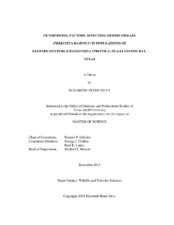| dc.description.abstract | The Gulf Coast has seen a dramatic decline in commercial oyster harvest in recent years. Lack of fresh-water inflow and elevated temperatures and salinities have been identified as factors contributing to increased Dermo disease of oysters, caused by the parasite Perkinsus marinus, which attacks their tissue and is responsible for individual oyster and oyster reef kills along the Gulf Coast. A disease has its largest detrimental effect on a host when environmental conditions support an abrupt increase in density of the pathogen population. Therefore, documenting the relationships between distribution and prevalence of Dermo disease in the eastern oyster (Crassostrea virginica) and environmental conditions would be beneficial to management of the eastern oyster in Galveston Bay.
My study consisted of four sites located in Galveston Bay, Texas, which were sampled 20 oysters every other month from November 2014 through September 2015. Specific objectives were to determine: (1) prevalence of Dermo in oysters, (2) spatial location of Dermo infected oysters, (3) concentrations of the parasite Dermo within infected oysters (Mackin Dermo Intensity Scale), and (4) the relationship of water quality parameters (i.e., fresh-water flow, salinity, water temperature, and water turbidity) to prevalence and parasite concentration of Dermo disease in oysters.
Initially (November 2014), Dermo was present in oysters at all reefs sampled, and Dermo prevalence was greatest at April Fool (0.55, intensity on Mackin Dermo Intensity Scale) and Confederate (0.85) reefs, but declined after heavy rainfall (July 2015, April Fool Reef: 0.21, Confederate Reef: 0.81). Linear regression analysis indicated water variables such as temperature, salinity, turbidity and fresh water inflow explained different amounts of the variability in the Mackin Dermo Intensity Scale among sampled reefs. Fresh-water inflow from the Trinity River explained the most variability in Dermo intensity at April Fool (61.8%), Fishers (44.5%), and Frenchy’s (46.9%) reefs. At Confederate Reef, salinity (20.6%) explained the most variability in Dermo intensity, and this reef was least affected by the Trinity River flow. I found that combinations of low fresh-water inflow, high salinity, and high temperatures accounted for majority the variance of Dermo in oysters located in Galveston Bay. However, this relationship was not necessarily a linear relationship with mortality, in that high fresh-water inflow also was related to oyster mortality at Fishers Reef. | en |


